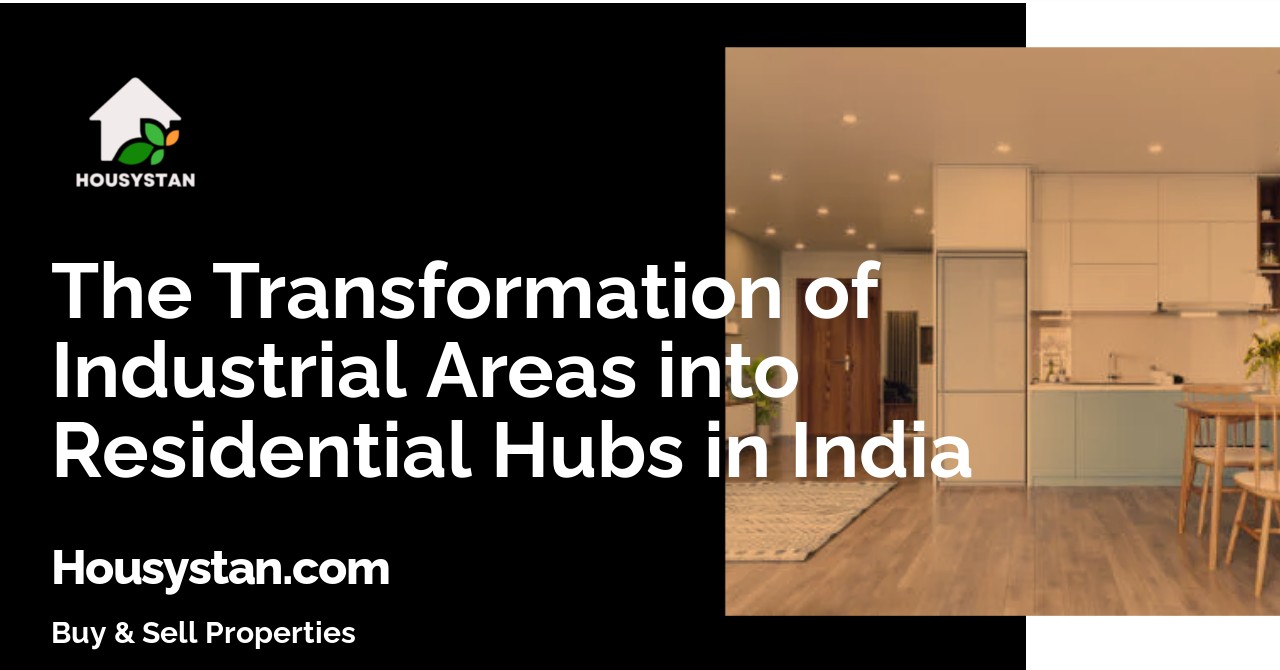The Transformation of Industrial Areas into Residential Hubs in India
Read latest blogs and articles from Housystan

The Information mentioned here was last updated on:
4/12/2025The Transformation of Industrial Areas into Residential Hubs in India
Introduction
India's urban landscape is undergoing a fascinating transformation. Once bustling industrial areas are now turning into vibrant residential hubs, reflecting the country's evolving priorities and economic shifts. This change is not just reshaping city skylines but also impacting the lifestyles of millions. From offering proximity to employment centers to creating a unique blend of modern living, these transformed areas are now prime real estate destinations.
The Rise of Mixed-Use Development
- Verified Tenants/Buyers
- Unlimited Property Listing
- Zero subscription/charges fee
Definition and Concept
Mixed-use development is at the core of this transformation. But what exactly does mixed-use mean? Simply put, it's an amalgamation of residential, commercial, and sometimes industrial spaces within the same vicinity. This concept has gained popularity worldwide and is now taking center stage in India's urban planning.
- Benefits of Mixed-Use Development:
- Convenience: Residents enjoy shorter commutes and easy access to amenities.
- Vibrant Communities: The integration of varied spaces fosters a sense of community.
- Sustainability: Reduced need for travel can lead to lower carbon footprints.
Examples in India
Cities such as Mumbai, Bangalore, and Hyderabad have embraced mixed-use developments. Areas like Lower Parel in Mumbai and Whitefield in Bangalore are prime examples where old mills and factories have given way to posh apartments, shopping complexes, and office spaces.
Factors Driving the Transformation
Economic Shifts
The Indian economy has seen a significant shift from manufacturing to a services-oriented approach. This shift has made some old industrial zones less relevant, paving the way for residential development.
- Service Sector Boom: The rise in IT and services industries demands new residential zones closer to workplaces.
- Foreign Investments: Increased foreign investment in real estate has accelerated these transformations.
Urbanization and Population Growth
India's rapid urbanization and population growth mean that cities are expanding beyond their traditional boundaries, necessitating the redevelopment of industrial areas to meet housing demands.
Government Policies and Initiatives
The Indian government has launched initiatives to encourage the redevelopment of brownfield sites (previously industrial areas).
- Smart Cities Mission: Encourages sustainable urban development.
- RERA (Real Estate Regulatory Authority): Protects home buyer interests, giving confidence to developers and buyers alike.
Challenges in Transforming Industrial Areas
Despite the numerous advantages, transforming industrial areas into residential hubs is not without challenges.
Environmental Concerns
- Contamination: Many industrial areas have soil and groundwater contamination issues that need addressing before redevelopment.
- Pollution: Existing industrial pollution can pose a challenge to creating healthy living conditions.
Infrastructure and Logistics
- Existing Infrastructure: Industrial areas usually lack residential infrastructure, requiring significant investment.
- Traffic Congestion: Increased population in these areas can lead to traffic issues if not planned properly.
Key Players in the Transformation Process
Several stakeholders play vital roles in the successful transition of industrial areas into residential regions.
- Real Estate Developers: They bring in investment and expertise to convert these areas into livable spaces.
- Urban Planners: Essential in designing layouts that integrate residential, commercial, and recreational facilities.
- Local Governments: Provide necessary approvals and create policies that shape the redevelopment process.
Impact on Local Economies and Communities
Job Creation
The shift from industrial to residential changes the job landscape. While manufacturing jobs may decrease, there's a rise in opportunities in retail, services, and construction.
- New Retail and Service Jobs: Emerging commercial spaces create jobs in retail and services.
- Construction Boom: Building new homes and infrastructure stimulates the construction sector.
Social and Cultural Impact
Residential transformations can lead to a renaissance of local culture and social interaction spaces.
- Community Spaces: New malls, parks, and cultural spaces promote social interactions.
- Diversity: These areas often attract diverse populations, adding to cultural richness.
Case Studies of Successful Transformations
Looking at specific examples provides insights into how these transitions are managed effectively.
Lower Parel, Mumbai
Once dotted with textile mills, Lower Parel is now an upscale commercial and residential area hosting high-end restaurants, corporate offices, and premium residential towers.
Electronic City, Bangalore
Originally designed as an industrial area, Electronic City has evolved into a tech hub with a mixture of corporate offices and residential complexes, providing living options close to workplaces.
Future Outlook for Industrial-to-Residential Transformations
As India continues to urbanize, the trend of transforming industrial areas into residential hubs is expected to grow. With continued investment in infrastructure and sustainable development practices, these areas promise to become the urban spaces of tomorrow, incorporating green technology and smart city planning. Adapting to changing consumer preferences and ensuring community well-being will remain crucial, as urban landscapes evolve to meet modern demands.
Conclusion
The metamorphosis of industrial areas into residential hubs in India showcases the adaptability and dynamism of urban development in the country. As these projects advance, the need for thoughtful planning and sustainable practices will ensure that these transformed spaces contribute positively to the urban fabric. Understanding the balance between development and sustainability will redefine how cities grow, making them more livable, inclusive, and resilient for future generations.